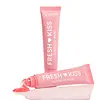What's inside
What's inside
 Key Ingredients
Key Ingredients

 Benefits
Benefits

 Concerns
Concerns

No concerns
 Ingredients Side-by-side
Ingredients Side-by-side

Bis-Behenyl/Isostearyl/Phytosteryl Dimer Dilinoleyl Dimer Dilinoleate
EmollientDiisostearyl Malate
EmollientPolyisobutene
Hydrogenated Polyisobutene
EmollientOctyldodecanol
EmollientCaprylic/Capric Triglyceride
MaskingPolyglyceryl-2 Triisostearate
EmulsifyingParaffin
PerfumingSilica Dimethyl Silylate
EmollientMicrocrystalline Wax
Emulsion StabilisingStearalkonium Hectorite
Gel FormingAroma
Propylene Carbonate
SolventTocopheryl Acetate
AntioxidantIsohexadecane
EmollientAspartame
Pentaerythrityl Tetra-Di-T-Butyl Hydroxyhydrocinnamate
AntioxidantTocopherol
AntioxidantEthylene/Propylene/Styrene Copolymer
Butylene/Ethylene/Styrene Copolymer
Phenoxyethanol
PreservativeSodium Hyaluronate
HumectantXanthan Gum
EmulsifyingAluminum Hydroxide
EmollientTripeptide-1
Skin ConditioningCI 77891
Cosmetic ColorantCI 19140
Cosmetic ColorantCI 15850
Cosmetic ColorantIron Oxides
Bis-Behenyl/Isostearyl/Phytosteryl Dimer Dilinoleyl Dimer Dilinoleate, Diisostearyl Malate, Polyisobutene, Hydrogenated Polyisobutene, Octyldodecanol, Caprylic/Capric Triglyceride, Polyglyceryl-2 Triisostearate, Paraffin, Silica Dimethyl Silylate, Microcrystalline Wax, Stearalkonium Hectorite, Aroma, Propylene Carbonate, Tocopheryl Acetate, Isohexadecane, Aspartame, Pentaerythrityl Tetra-Di-T-Butyl Hydroxyhydrocinnamate, Tocopherol, Ethylene/Propylene/Styrene Copolymer, Butylene/Ethylene/Styrene Copolymer, Phenoxyethanol, Sodium Hyaluronate, Xanthan Gum, Aluminum Hydroxide, Tripeptide-1, CI 77891, CI 19140, CI 15850, Iron Oxides
Polybutene
Hydrogenated Polydecene
EmollientBis-Diglyceryl Polyacyladipate-2
EmollientHydrogenated Styrene/Isoprene Copolymer
Cera Microcristallina
Emulsion StabilisingSilica
AbrasiveRubus Chamaemorus Seed Oil
Skin ConditioningGarcinia Indica Seed Butter
Skin ConditioningEuterpe Oleracea Sterols
Skin ConditioningPalmitoyl Hexapeptide-12
Skin ConditioningPalmitoyl Tripeptide-1
Skin ConditioningTocopheryl Acetate
AntioxidantTocopherol
AntioxidantIrvingia Gabonensis Kernel Butter
Skin ConditioningCitrus Aurantium Dulcis Fruit Extract
MaskingLinoleic Acid
CleansingLinolenic Acid
CleansingOleic Acid
EmollientLactic Acid
BufferingHelianthus Annuus Seed Oil
EmollientCaprylic/Capric Triglyceride
MaskingCopernicia Cerifera Wax
Hydrogenated Coco-Glycerides
EmollientSorbitan Isostearate
EmulsifyingPentaerythrityl Tetraisostearate
EmollientPentaerythrityl Tetra-Di-T-Butyl Hydroxyhydrocinnamate
AntioxidantOctyldodecanol
EmollientEthylhexyl Palmitate
EmollientDicalcium Phosphate
AbrasiveTribehenin
EmollientPropylene Carbonate
SolventStearalkonium Hectorite
Gel FormingParfum
MaskingCitral
PerfumingLimonene
PerfumingLinalool
PerfumingIron Oxides
CI 77891
Cosmetic ColorantPolybutene, Hydrogenated Polydecene, Bis-Diglyceryl Polyacyladipate-2, Hydrogenated Styrene/Isoprene Copolymer, Cera Microcristallina, Silica, Rubus Chamaemorus Seed Oil, Garcinia Indica Seed Butter, Euterpe Oleracea Sterols, Palmitoyl Hexapeptide-12, Palmitoyl Tripeptide-1, Tocopheryl Acetate, Tocopherol, Irvingia Gabonensis Kernel Butter, Citrus Aurantium Dulcis Fruit Extract, Linoleic Acid, Linolenic Acid, Oleic Acid, Lactic Acid, Helianthus Annuus Seed Oil, Caprylic/Capric Triglyceride, Copernicia Cerifera Wax, Hydrogenated Coco-Glycerides, Sorbitan Isostearate, Pentaerythrityl Tetraisostearate, Pentaerythrityl Tetra-Di-T-Butyl Hydroxyhydrocinnamate, Octyldodecanol, Ethylhexyl Palmitate, Dicalcium Phosphate, Tribehenin, Propylene Carbonate, Stearalkonium Hectorite, Parfum, Citral, Limonene, Linalool, Iron Oxides, CI 77891
 Reviews
Reviews

Ingredients Explained
These ingredients are found in both products.
Ingredients higher up in an ingredient list are typically present in a larger amount.
This ingredient is an emollient, solvent, and texture enhancer. It is considered a skin-softener by helping the skin prevent moisture loss.
It helps thicken a product's formula and makes it easier to spread by dissolving clumping compounds.
Caprylic Triglyceride is made by combining glycerin with coconut oil, forming a clear liquid.
While there is an assumption Caprylic Triglyceride can clog pores due to it being derived from coconut oil, there is no research supporting this.
Learn more about Caprylic/Capric TriglycerideCi 77891 is a white pigment from Titanium dioxide. It is naturally found in minerals such as rutile and ilmenite.
It's main function is to add a white color to cosmetics. It can also be mixed with other colors to create different shades.
Ci 77891 is commonly found in sunscreens due to its ability to block UV rays.
Learn more about CI 77891Octyldodecanol is a fatty alcohol. It is primarily used to enhance the texture of products.
As an emulsifier, Octyldodecanol helps prevent the oils and waters from separating. It also prevents ingredients from creating foam when shaken.
Octyldodecanol is created by reducing fatty acid to an alcohol.
Due to its high molecular weight, it does not get absorbed into the skin.
Learn more about OctyldodecanolPentaerythrityl Tetra-Di-T-Butyl Hydroxyhydrocinnamate (long name, huh?) is a synthetic antioxidant.
It is used to help stabilize other antioxidants or prevent the color from changing in a product.
As an antioxidant, it helps fight free-radical molecules. Free-radical molecules are capable of damaging our cells and other genetic material. Thus, antioxidants may reduce the signs of aging.
This ingredient is oil-soluble.
Learn more about Pentaerythrityl Tetra-Di-T-Butyl HydroxyhydrocinnamateThis ingredient is a solvent. It helps dissolve active ingredients and alter the texture of products.
Propylene Carbonate is commonly used in makeup and with clay, such as montmorillonite or bentonite.
Studies show this ingredient to be safe for cosmetics. When it is undiluted, it can cause skin irritation. (It is always diluted in skincare and makeup). This ingredient is water-soluble.
Propylene Carbonate is created from propylene glycol and carbonic acid.
Learn more about Propylene CarbonateStearalkonium Hectorite is a clay-derived ingredient used to thicken a product and help create a gel-like texture.
Tocopherol (also known as Vitamin E) is a common antioxidant used to help protect the skin from free-radicals and strengthen the skin barrier. It's also fat soluble - this means our skin is great at absorbing it.
Vitamin E also helps keep your natural skin lipids healthy. Your lipid skin barrier naturally consists of lipids, ceramides, and fatty acids. Vitamin E offers extra protection for your skin’s lipid barrier, keeping your skin healthy and nourished.
Another benefit is a bit of UV protection. Vitamin E helps reduce the damage caused by UVB rays. (It should not replace your sunscreen). Combining it with Vitamin C can decrease sunburned cells and hyperpigmentation after UV exposure.
You might have noticed Vitamin E + C often paired together. This is because it is great at stabilizing Vitamin C. Using the two together helps increase the effectiveness of both ingredients.
There are often claims that Vitamin E can reduce/prevent scarring, but these claims haven't been confirmed by scientific research.
Learn more about TocopherolTocopheryl Acetate is AKA Vitamin E. It is an antioxidant and protects your skin from free radicals. Free radicals damage the skin by breaking down collagen.
One study found using Tocopheryl Acetate with Vitamin C decreased the number of sunburned cells.
Tocopheryl Acetate is commonly found in both skincare and dietary supplements.
Learn more about Tocopheryl AcetateThis ingredient is a combination of red, black, and yellow iron oxide pigments. This combination of colors is usually found in foundation, because it results in a "skin" color.